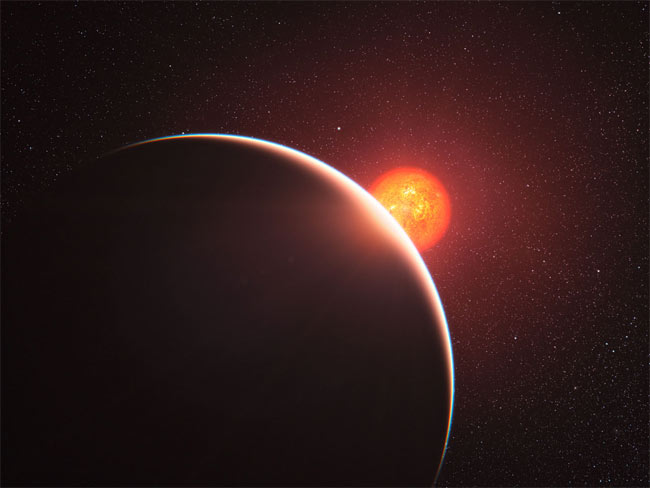Atmosphere of Alien Super-Earth Revealed for First Time

The first-ever analysis of the atmosphere of an alien planetclassified as a so-called "super-Earth" has revealed a distant worldthat is likely covered with either water vapor or a thick haze, scientistsannounced today (Dec. 1).
The exoplanetGJ 1214b, which orbits a star 40 light-years from Earth, offers astronomersa unique chance to study its atmosphere because it passes directly in front ofits parent star from Earth's line of sight. That means that once an orbit, thestar's light is filtered as it passes through the planet's atmosphere on itsway to Earth, taking with it an imprint from the chemicals there. [Illustrationof alien planet GJ 1214b]
"We're trying to get at: What's the main component ofthis planet's atmosphere?" said lead researcher Jacob Bean, an astronomerat the Harvard-Smithsonian Center for Astrophysics in Cambridge, Mass.
GJ 1214b is called a super-Earthbecause it is larger than our home planet but smaller than gas giants likeJupiter and Saturn. It was first discovered in 2009 and has been studied eversince.
A watery super-Earth?
Among our solar system's inhabitants, Neptune is the planetthat most closely resembles GJ 1214b, Bean said. The alien planet has a radius2.5 times the size of Earth's and has about 6.5 times the mass, researcherssaid.
Astronomers have discovered morethan 500 alien planets beyond our solar system so far, with hundredsmore expected to be confirmed in upcoming months.
Get the Space.com Newsletter
Breaking space news, the latest updates on rocket launches, skywatching events and more!
Bean and his colleagues observed the system with the FORSinstrument on the European Southern Observatory's Very Large Telescope inChile. The instrument analyzes the spectrum of light from a target to determinethe object's composition.
Rather than find a signal crawling with interestingelements, the scientists discovered that GJ 1214b's atmosphere bears arelatively flat, featureless signature.
"That might seem a bit boring, but that's actually avery powerful constraint," Bean told SPACE.com.
It means, for example, that the exoplanet's atmosphere can'tcontain much hydrogen, which typically leaves a strong feature in the spectrumof light coming from a planet.
The astronomers concluded that the alien world's atmosphereis most likely dominated by water vapor or blanketed by a haze of clouds thatis blocking other chemicals underneath.
"This isn't a definitive result, but it's veryexciting," Bean said. "It points the way toward the future."
Gazing below alien planet's cloud
The scientists hope to follow up with more detailedobservations, particularly in the infrared range of light that might be able topenetrate the possible cloud cover. [Gallery:Strangest Alien Planets]
Although the prospect of water vapor may sound promising inthe search for extraterrestrial life, scientists said GJ 1214b is not acandidate for hosting life. That's because the planet is probably way too warmfor liquid water to exist in large quantities.
"This planet has basically no potentiality forhabitability, whether it has a puffy atmosphere or a cloud atmosphere,"Bean said.
Super-Earths are easier to detect than a relatively small,dim Earth-like planet would be, yet are more difficult to find than bright,large gas giants, so they represent the cutting edge in astronomers' ability tostudy planets beyond the solar system.
"Super-Earths are really at the frontier of exoplanetresearch right now," Bean said. "We've gotten to the point where wecan finally discover and characterize these planets. I think over the next fewyears there's really going to be an explosion of work done in this area."
The results of the study are detailed in tomorrow's (Dec. 2)issue of the journal Nature.
- Video:Super Earth Alien Exoplanet
- Gallery: Strangest Alien Planets
- How Do Astronomers Find Exoplanets?
You can follow SPACE.com senior writer Clara Moskowitz on Twitter @ClaraMoskowitz.
Join our Space Forums to keep talking space on the latest missions, night sky and more! And if you have a news tip, correction or comment, let us know at: community@space.com.

Clara Moskowitz is a science and space writer who joined the Space.com team in 2008 and served as Assistant Managing Editor from 2011 to 2013. Clara has a bachelor's degree in astronomy and physics from Wesleyan University, and a graduate certificate in science writing from the University of California, Santa Cruz. She covers everything from astronomy to human spaceflight and once aced a NASTAR suborbital spaceflight training program for space missions. Clara is currently Associate Editor of Scientific American. To see her latest project is, follow Clara on Twitter.









